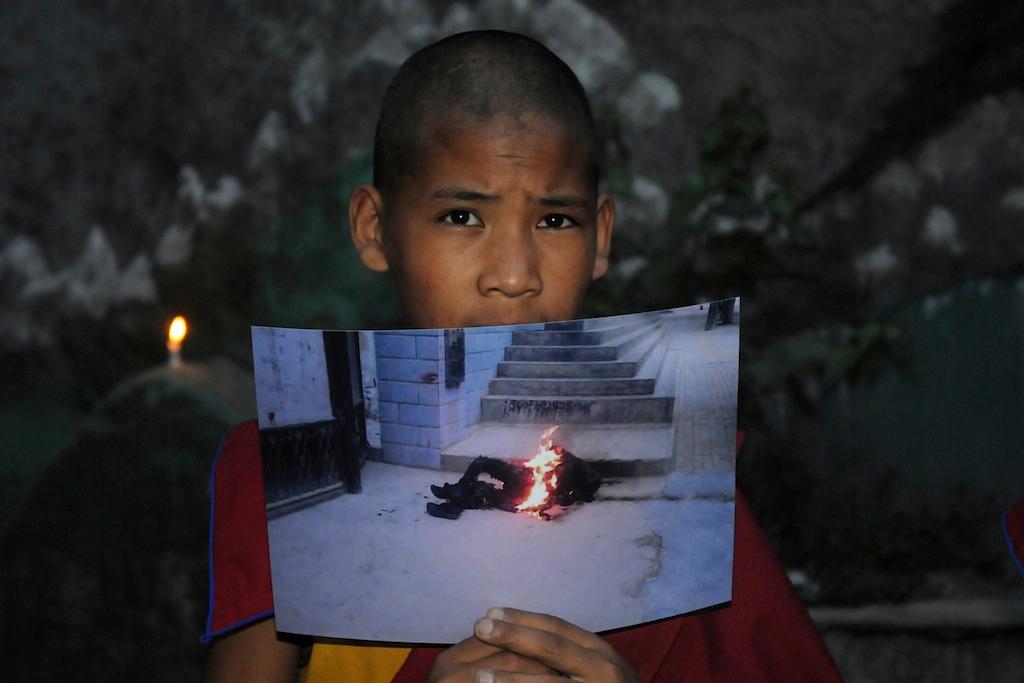China pushing Tibet into total isolation as self-immolations near 100
An exiled Tibetan monk holds a picture of 50-year-old, Tamdin Thar, who burned himself to death to protest against the Chinese rule in Tibet during a rally on June 15, 2012. Chinese authorities have gotten increasingly strict with Tibetans, as self-immolations continue.
The frigid air smelled strongly of gasoline when they discovered the lifeless body of seventeen-year-old Jigji Kyab near a busy intersection in Luchu, Tibet on January 19. He was soaked in it, a lighter in each hand. Kyab had gone to the intersection to burn himself alive, swallowing fox poison before leaving so he wouldn’t survive to be locked away in a Chinese military hospital.
He succumbed to the poison before he could complete his final act. Later his parents found a note beside his bed, written in neat Tibetan print on school paper, that explained why he had chosen to sacrifice his life and conveyed his love one last time.
We know of 98 Tibetans who have self-immolated inside Tibet since February 2009. Jigji Kyab isn’t on that list, and there are probably others missing from it, too. It took four months—from September 13 to January 14—for reports to leak that 62-year-old Passang Lhamo had self-immolated in Beijing, the capital of China. How many self-immolations and other protests don’t we know about from within remote parts of Tibet itself—which is now largely closed off to foreigners, including journalists?
China has been moving to complete Tibet’s isolation in recent weeks. Radio Free Asia recently reported that Chinese officials have confiscated and burned satellite dishes in eastern Tibet to keep Tibetans from listening to exile broadcasts that carry news of self-immolation protests in other areas. Likewise, last year Students for a Free Tibet reported that Chinese officials in eastern Tibet were strengthening restrictions on internet cafes, requiring all patrons to register with a government ID.
More from GlobalPost: Self-immolators and the Dalai Lama: what they don't have in common
According to the Washington Post, officials have also confiscated Tibetans’ passports to replace them with electronic ones—without actually providing the new passports. This has left most Tibetans inside Tibet unable to legally travel to India or Nepal, where rights groups are located.
This makes Western journalists dependent on reports from exile Tibetans with relatives in the affected areas; advocacy groups like the International Campaign for Tibet and Free Tibet; and Radio Free Asia (RFA), which is largely funded by the U.S. government. Because so much news from inside Tibet comes either from advocacy groups or explicitly ideological media outlets like RFA or Phayul.com, much of it also goes unreported in the mainstream press.
There’s every possibility China may need a media blackout. February 11 is the Tibetan New Year. Soon afterward comes March 10, the anniversary of a major uprising in the Tibetan capital of Lhasa in 1959 that is commemorated every year with Tibetan Uprising Day. The subsequent uprisings of 1987 to 1989 and 2008 all began around March 10, as did the current wave of self-immolations. March also saw a spike in self-immolations last year.
More from GlobalPost: 50 self-immolations later, what, if anything, has changed?
This year will be especially volatile. In early March, China will complete its once-a-decade leadership transition as Xi Jinping takes over the presidency from Hu Jintao. Many Tibetans expect Xi to take a more liberal line on Tibet because his father, Xi Zhongxun, was close with the current Dalai Lama. But Kate Saunders of the International Campaign for Tibet recently told Reuters that “things might get worse before they get better, because he will want to stamp his authority early on.” The newly elected, hardline governor of the Tibetan Autonomous Region will only make things worse.
If Occupy, the Arab Spring, and the Printemps Érable taught us anything, it’s that trying to predict revolutions is a fool’s errand. Still, while it may not happen this March, it is hard to imagine that tensions behind Tibet’s self-immolations won’t boil over into a mass uprising eventually.
Can China maintain its blackout when they do? The smell of gasoline is awful strong.
